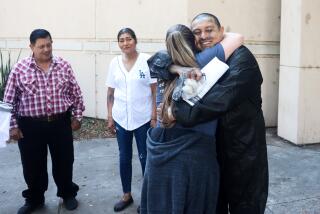Dispute Lingers in Hammer Death : Man Smashed 32 Times on Head; Police Insist It’s Suicide
- Share via
HOBART, Ind. — It has the makings of classic mystery: man found dead in basement, skull smashed and bloodied by 32 hammer blows. Police say it’s suicide. Coroner insists it’s murder.
This is no TV plot with a twist ending, however. It is the true story of a 52-year-old man whose death set off a debate that lingers nearly eight months later.
The death of James Cooley has pitted the police against a county coroner who jokingly compares himself to “Quincy,” TV’s dogged coroner-sleuth. Investigators cite strange textbook cases as proof that anything is possible.
‘Most Bizarre Case’
“It’s probably the most bizarre case our department has investigated,” said Police Chief Lawrence Juzwicki.
Persons from thousands of miles away who read about Cooley contacted Hobart police to discuss other unusual deaths. One retired police officer recalled his investigation into an attempted hammer suicide.
It’s all very atypical for Hobart, a city of 23,000 in northwestern Indiana. Unlike nearby Gary, which has one of the nation’s highest murder rates, killings are unusual in Hobart. The last was in 1981.
Originally, police officers had thought that they were dealing with a homicide when, on April 6, Diane Cooley discovered her husband’s body in a basement photo darkroom.
Skull Fractured Twice
An autopsy showed that Cooley’s skull had been fractured in two places. Ten of the 32 blows were severe enough to have knocked him senseless, Lake County Coroner Daniel Thomas concluded.
However, as police officers pursued their investigation, it did not square with murder, Juzwicki said. “The evidence we gathered supports the suicide finding.”
What detectives found was a depressed man fighting cancer. What they did not find was a suspect or motive. No signs of struggle. No forced entry. Nothing missing. They consulted experts, who concluded Cooley probably killed himself.
Case closed. Suicide.
Thomas was outraged.
“It’s a homicide, and we’re not going to let it go by as a suicide,” he declared. “This case is ludicrous. It’s a laughing matter.”
Surgeon for 21 Years
The wounds “were so massive there was no doubt,” said Thomas, a surgeon for 21 years and coroner since 1983. His office investigated 110 killings last year. Three days after Cooley’s death, Thomas ruled homicide. Cause: severe injuries to the brain.
Although Thomas has the final word only on the death certificate, he is not willing to let the case die with a difference of opinion. He repeated his findings to assembled reporters recently. He has asked the county prosecutor and state police to investigate.
Cooley’s family has remained out of the fray. However, his brother, John, said that “the entire family, the entire city of Hobart wants the case reopened. We’re not satisfied.”
At the heart of the dispute is whether Cooley was inclined to kill himself and whether he could have hit himself 32 times with a claw hammer--hard enough to fracture his skull twice.
Victim in ‘Terrible Shape’
Cooley had extensive cancer in his neck, his doctor said. He had been in and out of the hospital for months for treatment, which left him in “terrible shape,” said police detective Daniel Topper.
On the day he died, Mrs. Cooley told police, her husband was “despondent” and his legs were hurting. When she suggested that they go to a hotel to soak in a whirlpool, he refused, police said. When he became agitated, Topper said, she left the house.
Other family members confirmed to police that Cooley had been moody and unsure about his future.
Thomas has a different view. He said family members told him that Cooley was thinking of returning to work as a Conrail supervisor. He was also working on his darkroom.
“He had plans, (things) he wanted to do,” the coroner said.
Lost 2 Quarts of Blood
Thomas said that “it would have been humanly impossible” for a man to hit himself as often and as hard as Cooley was hit without being knocked out. He said that Cooley lost about two quarts of blood, enough to put him in shock.
The fractures, the loss of blood and the swelling and hemorrhaging in Cooley’s brain--”any of these would be sufficient to cause death,” Thomas said.
Another curious thing is that Cooley was right-handed. Yet the blows were all to the back and top of the head, many on the left side. The claws of the hammer made neat, parallel wounds.
“If he was inflicting the wounds himself, he would be stunned. They wouldn’t be parallel. They would be staggered” and oblique, Thomas said.
Thomas said that two neurosurgeons and two pathologists concurred with his findings, including Dr. John Pless, division director of forensic pathology at the Indiana University School of Medicine.
Expert Doubts Suicide
“The number of wounds, the angles, the direction of force, the severity of force . . . it’s unlikely anyone would be be able to inflict those blows on themselves and remain conscious,” Pless said.
It is possible Cooley struck himself, Pless added in a letter to the coroner, “but only in the realm of anything is possible.”
The point is, police say, that anything is possible in suicide.
In investigating Cooley’s death, Hobart police pored over a book detailing unusual suicides. In one case, a man hit himself on the head with a hatchet more than 20 times.
Sgt. Rod Englert, a homicide detective in the Multnomah County sheriff’s office in Portland, Ore., told them of a man who had run his body through a band saw and a woman who had stepped into a scalding bath, cut her wrists, taken poison and then hit herself on the head.
“People have different tolerances of pain,” he said.
Similar Suicides Cited
There have been hammer suicides, too, said Dr. Robert Kirschner, associate professor of pathology at the University of Chicago and a deputy Cook County medical examiner. He was not involved in the Cooley case.
Kirschner knew of one person who hit himself with a hammer four or five times.
But he added, “If you ask me, if there are more suicides or homicides of people hitting themselves on the head with a hammer, for every one suicide there’s probably 100 to 200 homicides.”
More to Read
Sign up for Essential California
The most important California stories and recommendations in your inbox every morning.
You may occasionally receive promotional content from the Los Angeles Times.










